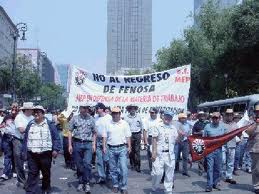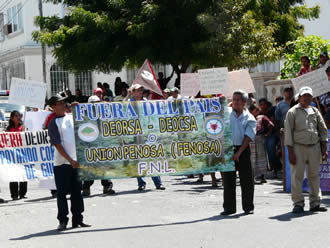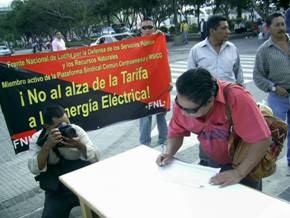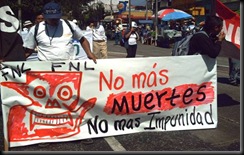Referring to the energy market in Nicaragua during the 1990s, John Perry states that:
If there was a ‘strategic vision’ for the energy sector it was to privatise both the generators and the distribution system, make even greater use of oil, and trust the private sector to start to invest in a more modern system. The geothermal plant was privatised and the hydro-electric plant allowed to run down to the point where it operated well below capacity.[i]
The privatisation of the electricity distribution system in Nicaragua involved the Spanish transnational company Unión Fenosa, now generally referred to as ‘Unión Fenosa – Gas Natural’ as a result of the purchase of the company by another Spanish transnational energy company, Gas Natural. Because of its significance in the region, a brief summary of the company’s activities in Central America is given in the box following this text.
Although most urban areas in Nicaragua had electricity, in 1990 half the population were still not connected to the grid, but Nicaragua could ill-afford to challenge the imposition of the privatisation of the energy system by the World Bank, IMF and IDB. In any case, for 17 years [1990 – 2007] it had governments that embraced them enthusiastically and were able to portray them to critics as inescapable requirements.[ii]
The crown jewel of privatisation was the electricity distribution system. Only one company, Unión Fenosa, made a bid. It created two distribution companies and various offshoots to give the appearance of not being a monopoly, and bought the whole system with its bid of only $115 million (slightly more than half the value placed on it by the government). As well as the infrastructure, it acquired Nicaragua’s limited technical expertise – the engineers and economists who run the system, and even the laboratory which tests household meters.
Nicaragua therefore entered the current century with a newly-privatised electricity system covering only half the population, massively dependent on oil imports, and charging the highest consumer prices of any country in the region. The government had limited regulatory ability to control a multinational company whose contract was, in any case, underwritten by World Bank guarantees. It had also completely failed to develop alternative, more sustainable power sources, which might have increased its flexibility in dealing with the Spanish multinational.
Despite the promises, privatisation brought little new investment, so not only was power generation based on imported oil, it took place in old and inefficient power stations afflicted by frequent breakdowns. A combination of mismanagement and large numbers of illegal connections meant that, of the power that was generated and passed to Fenosa, some 30 per cent was still being lost before reaching legitimate end users.
While higher prices in Britain affect transport costs and might lead people to curb optional travel or switch to public transport, in Nicaragua the effects of oil costing up to $100 per barrel have been much more dramatic. The cost of basic foods has increased by up to 40 per cent, and the daily bus journey to work might consume most of your weekly earnings.
Despite the fact that the original sale had factored in guaranteed profit levels, and had even assumed a high level (15 per cent) of ‘technical losses’ in the distribution system, Fenosa has persistently sought higher prices or has added extra charges to bills. Electricity prices in Nicaragua are higher than anywhere else in Central America.
In 2006 and 2007, amidst widespread protests and a situation described by one of the main national newspapers as living “… in a state of catastrophe”, the power cuts were extended and formalised so in most places they lasted up to ten hours per day. The effect on the economy was disastrous.
Yet these problems only directly affect half the population, as the other half continue to have no connections to the grid. The system has hardly grown at all since Fenosa took it over. Although its bid contained promises of investment, there was no contractual timetable about how and where this should take place. In fact, where rural areas have secured electricity for the first time, this has been through international aid rather than as a result of investment by Fenosa.
President Daniel Ortega has described Unión Fenosa as “a mafia; it is a mafia structure that uses gangster tactics within the global economy.”[iii] Compared with what Unión Fenosa does elsewhere in Central America, its operations in Nicaragua appear tame. In Guatemala, for instance, its behaviour is more appropriately described as gangster-like.
[i] Op. cit., John Perry, page 231.
[ii] I am grateful to John Perry for his permission to use this summary of the case study of Nicaragua’s electricity privatisation which was provided in Chapter 17 (‘The debate on energy and climate change – a different perspective’, 2008, pp.229-244) of a book published by The Chartered Institute of Housing entitled ‘Housing, the Environment and our Changing Climate’.
[iii] President Daniel Ortega quoted by Luis Alemán (12 November 2007) ‘Fenosa “oídos sordos”’, El Nuevo Diario, Managua, Nicaragua.
 On 11 January 2010 a delegation of members of FRENA (Resistance Front in Defence of Natural Resources and the Rights of People and Communities) held meetings in Guatemala City with various civil society organisations and government authorities, including the Ministry of Defence, the Ministry of the Interior and the Secretary General of the Presidency. The meetings were organised to present extensive documentation of complaints against DEOCSA, one of the two electricity distribution companies set up by Unión Fenosa.
On 11 January 2010 a delegation of members of FRENA (Resistance Front in Defence of Natural Resources and the Rights of People and Communities) held meetings in Guatemala City with various civil society organisations and government authorities, including the Ministry of Defence, the Ministry of the Interior and the Secretary General of the Presidency. The meetings were organised to present extensive documentation of complaints against DEOCSA, one of the two electricity distribution companies set up by Unión Fenosa.

 Rather than an explanation, this sounds like questionable reasoning for privatisation, and it highlights the problems caused by large-scale electricity generation with its talk of blasting mountains and flooding acres of land. It also raises the question of why large companies or institutions are unable to work at the small-scale. Logically, it is easy to see why small companies may not be able to work at the large-scale; but there is no reason why large companies cannot work at the small-scale. With such feeble justifications it is not surprising that opposition to the privatisation promotion strategy is likely to rise again. As José María Villalta, a congressman for the Broad Front Party has said:
Rather than an explanation, this sounds like questionable reasoning for privatisation, and it highlights the problems caused by large-scale electricity generation with its talk of blasting mountains and flooding acres of land. It also raises the question of why large companies or institutions are unable to work at the small-scale. Logically, it is easy to see why small companies may not be able to work at the large-scale; but there is no reason why large companies cannot work at the small-scale. With such feeble justifications it is not surprising that opposition to the privatisation promotion strategy is likely to rise again. As José María Villalta, a congressman for the Broad Front Party has said: